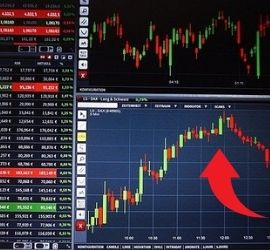What Does Buy to Cover Mean?
 Buy to cover refers to a buy order made on a stock or other listed security to close out an existing short position. A short sale involves selling shares of a company that an investor does not own. The shares are borrowed from a broker but need to be repaid at some point. Short selling is the process of borrowing shares from your broker to sell in the open market. The goal is to buy them back at a lower price. By initiating a buy-to-cover order, the trader is able to cover the short sale. This allows the shares to be returned to the original lender.
Buy to cover refers to a buy order made on a stock or other listed security to close out an existing short position. A short sale involves selling shares of a company that an investor does not own. The shares are borrowed from a broker but need to be repaid at some point. Short selling is the process of borrowing shares from your broker to sell in the open market. The goal is to buy them back at a lower price. By initiating a buy-to-cover order, the trader is able to cover the short sale. This allows the shares to be returned to the original lender.
Buy to cover is a buy trade order that closes a trader’s short position. Short positions are borrowed from a broker and a buy to cover allows the short positions to be “covered” and returned to the original lender. The trade is made on the belief that a stock’s price will decline, so shares are sold at a higher price and then bought back at a lower price. Buy to cover orders are generally margin trades.
How It Works
To better explain how the buy-to-cover order works, let’s look at an example. As a trader, you have information that Company ABC may be overvalued or its financial condition is deteriorating. As such, you feel its stock price currently does not reflect these conditions. Your savvy trading experience tells you that the stock price of Company ABC will likely fall. You can take advantage of this situation by simply placing a short sell order on the stock. However, since this is a short sale order, you will have to borrow the shares from your broker to sell in the market.
Once shares fall, you decide that it’s time to close your position by placing a buy to cover order. You can buy to cover with a limit or market order. Either will allow you to exit the trade and realize your gains. It is important to understand shorting requires you to use margin which can be very risky. This is because the potential of losses may occur as a result of broker margin calls. It is common for investors and traders to receive a margin call in the event the stock moves against your position.
(Source: warriortrading)
A Deeper Look
A buy to cover order involves purchasing an equal number of shares to those borrowed. This “covers” the short sale and allows the shares to be returned to the original lender. Typically, the lender is the investor’s own broker-dealer, who may have had to borrow the shares from a third party. A short seller is betting on a stock price going down and seeks to buy the shares back at a lower price than the original short sale price. The short seller must pay each margin call and repurchase the shares to return them to the lender.
Specifically, when the stock begins to rise above the price at which the shares were shorted, the short seller’s broker may require that the seller execute a buy to cover order as part of a margin call. To prevent this from happening, the short seller should always keep enough buying power in their brokerage account to make any needed “buy to cover” trades before the market price of the stock triggers a margin call.
(Source: investopedia)
Buy to Cover and Margin Trades
Investors can make cash transactions when buying and selling stocks. This means they can buy with cash in their own brokerage accounts and sell what they have previously bought. Alternatively, investors can buy and sell on margin with funds and securities borrowed from their brokers. Thus, a short sale is inherently a margin trade, as investors are selling something they do not already own.
Trading on margin is riskier for investors than using cash or their own securities because of potential losses from margin calls. Investors receive margin calls when the market value of the underlying security is moving against the positions they have taken in margin trades, namely the decline of security values when buying on margin, and the rise of security values when selling short. Investors must satisfy margin calls by depositing additional cash or making relevant buy or sell trades to make up for any unfavorable changes in the value of the underlying securities.
When an investor is selling short and the market value of the underlying security rises above the short-selling price, the proceeds from the earlier short sale are less than what is needed to buy it back. This results in a losing position for the investor. If the market value of the security continues to rise, the investor will have to pay increasingly more to buy back the security. If the investor does not expect the security to fall below the original short-selling price in the near term, they should consider covering the short position sooner than later.
(Source: ibid)
Buy to Cover Examples
Suppose a trader opens a short position in the stock of Company ABC. After research, the investor believes ABC’s stock price, currently trading at $20, will fall in the coming months. This is because the company’s financials are signaling that the company is in distress. To profit, the trader borrows 1000 shares of ABC from a broker and sells them in the open market at the current price of $20.
Buy to Cover Example 1 – Profitable
A profitable short sale would look like this:
- DayTradrr borrows 1,000 shares of ABC Corp. from a broker.
- DayTradrr sells these shares on the open market for $20 per share, which gains $20,000.
- The price of ABC Corp. then declines to $15 per share.
- DayTradrr buys 1,000 shares of ABC Corp. at the lower price, for a total of $15,000. Here, they are buying shares to cover their position.
- DayTradrr returns the 1,000 shares of ABC Corp. to the broker.
- DayTradrr sold the shares for more than it cost to buy them back, and makes $5,000 off the entire transaction.
Buy to Cover Example 2 – Unprofitable
- DayTradrr borrows 1,000 shares of ABC Corp. from a broker.
- DayTradrr sells these shares on the open market for $20 per share, which gains him $20,000.
- The price of ABC Corp. then increases to $25 per share.
- DayTradrr buys 1,000 shares of ABC Corp., which costs a total of $25,000. Here, they are buying shares to cover their position.
- DayTradrr returns the shares of ABC Corp. to the broker.
- DayTradrr made $20,000 off the initial sale, but it cost more than that to buy back the shares to cover the position. As a result, DayTradrr lost $5,000 off the entire transaction.
Short Covering and Buy to Cover — Are They the Same?
In a word, yes. Short covering is a term used for exiting a short position and returning the borrowed shares to the original broker. The action of short covering is a buy to cover order. Both terms mean you’re exiting a short position.
What’s the Difference Between Buy and Buy to Cover?
Most people understand the concept of buy low and sell high. It’s the most common goal when trading in the market. When you want to enter a position, you enter your price and the number of shares you want into the order box and hit buy. Simple right?
Buying to cover is completely different. When you buy to cover, you’re not entering a position. You’re exiting it. Remember, short selling involves borrowing shares. So when you buy to cover, you don’t own any shares. They’re returned to your broker.
How Long Do Short Sellers Have to Cover?
When entering a short position, there’s no time limit on how long you can hold. The amount of time depends on how much interest you are willing to pay to hold the shares. The costs can increase as the demand for borrowing increases. If a stock is heavily shorted and releases good news, it can trigger a short squeeze. If shorts don’t buy to cover their positions, the brokers will start calling them in.
Shorting has the potential for unlimited losses. You can lose more than you have in your trading account. If your loss is too big, the broker will close your position and you’re stuck with the loss. This is one reason why short selling isn’t for new traders. It’s easy to blow up a small account. It’s also a bad strategy for undisciplined traders. If you have trouble cutting losses. stay away from short selling.
Final Thoughts
Buying to cover, is also known as short-covering. It occurs when a trader buys stocks to cover the ones that were borrowed to open a short position. Buying to cover is how you close out a short position. And, it can result in a profit if the stocks lost value while the position was open. Risk in a short position is different from the risk in a long position.
Shorting a stock is very speculative and can result in large losses very quickly. However, it also allows you to profit from a falling stock. This, in turn, lets investors play the market both ways. However, trading a short position has a very different risk profile than a long position. In a long position, you buy stocks and profit when they increase in value. Also, your risk is limited by the purchase price of the stock. You can never lose more than your initial investment. You simply make your purchase, then wait to see what you get back in gains.
In a short position, your risk is not determined. You don’t have up-front costs beyond broker fees. So, you don’t stake any money up-front. Instead, the stock’s price determines your losses after the fact. This means that an unprofitable trade will lead you to actively lose money when you have to buy back the stock to close out your position. Moreover, there is no way of knowing how much money you will lose. The stock price can climb indefinitely, theoretically creating unlimited losses.
Up Next: Day Trading For Beginners – What Is A Day Trader?

Day trading can be summarized simply as buying securities and quickly selling or closing out the position within a single trading day. Ideally, a day trader wants to “cash-out” by the end of each day with no open positions to avoid the risk of losses by holding securities overnight. Day trading is not for everyone and carries significant risks. It requires an in-depth understanding of how the markets work and various strategies for profiting in the short term. Short term profits require a very different approach compared to traditional long term, buy and hold investment strategies.




